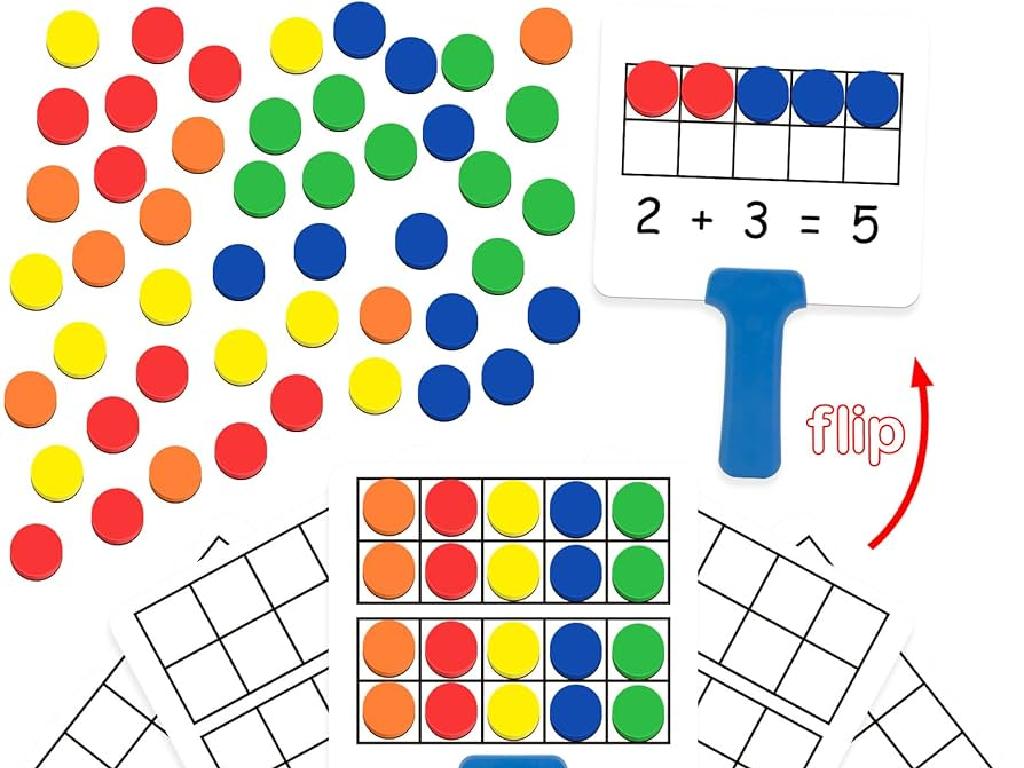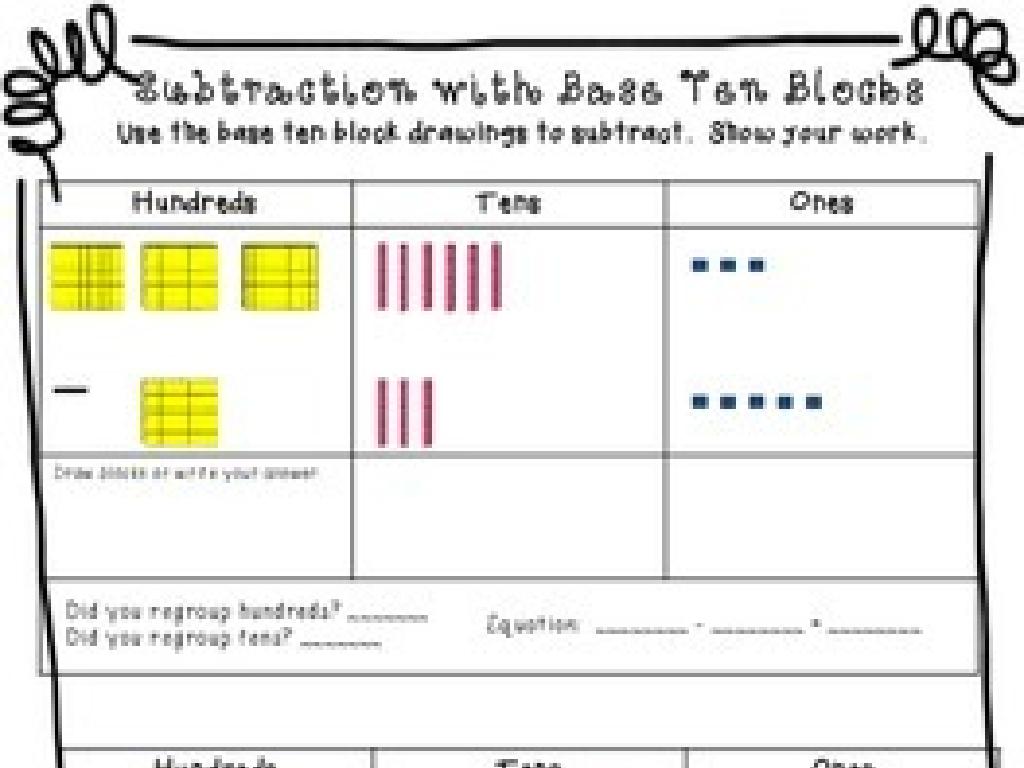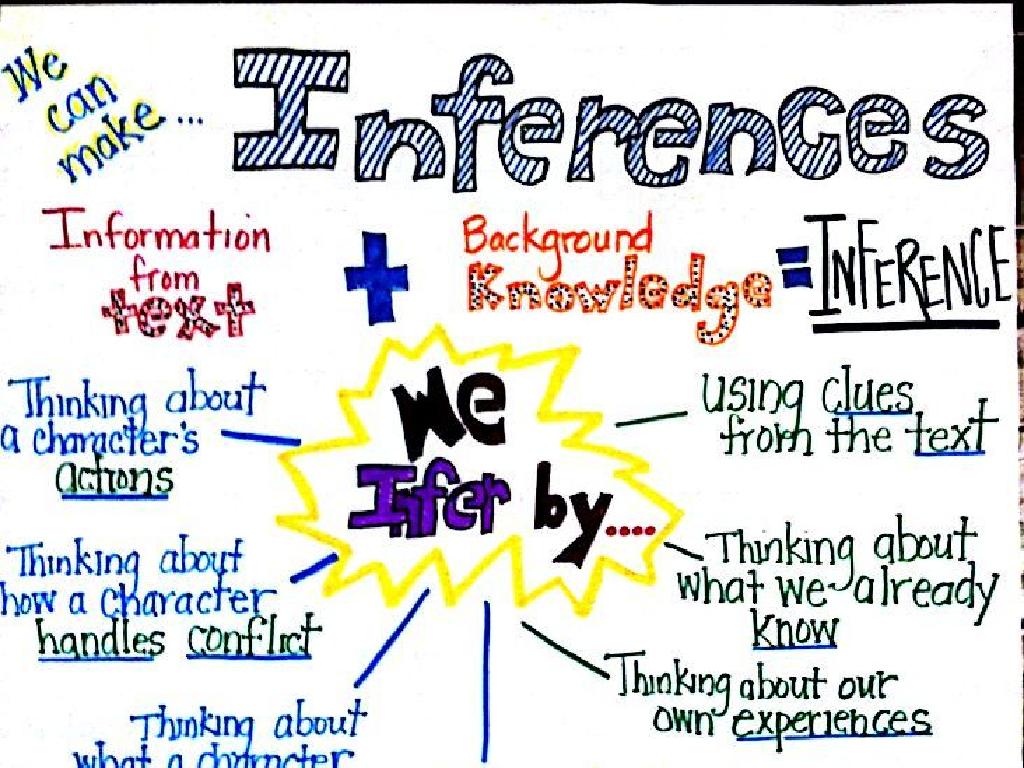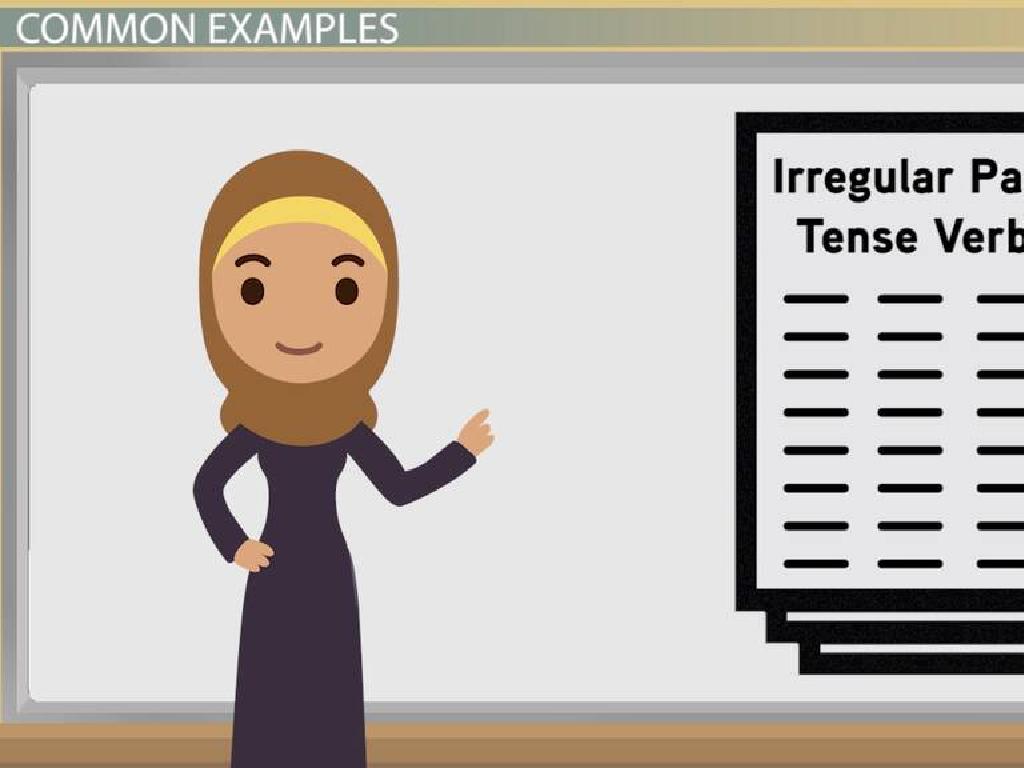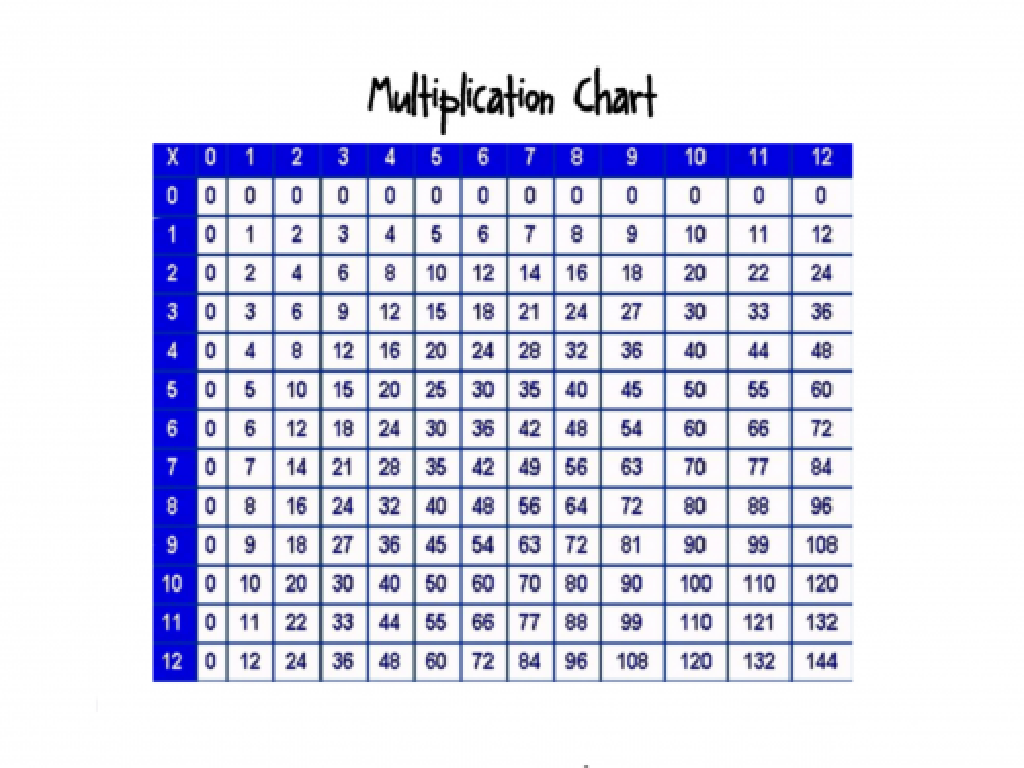Find Equivalent Fractions Using Area Models
Subject: Math
Grade: Fourth grade
Topic: Equivalent Fractions
Please LOG IN to download the presentation. Access is available to registered users only.
View More Content
Welcome to Equivalent Fractions!
– Understanding fractions
– Fractions represent parts of a whole
– Exploring equivalent fractions
– Fractions with different numbers but the same value
– Using area models
– Visual way to show fractions with shapes
– Today’s learning goal
|
This slide introduces the concept of equivalent fractions to fourth-grade students. Begin by explaining that fractions are a way to represent parts of a whole, ensuring they understand the terms numerator and denominator. Then, introduce the concept of equivalent fractions, which are different fractions that represent the same amount. Use area models, such as shaded parts of a rectangle, to visually demonstrate how different fractions can be equivalent. The goal for today’s lesson is for students to learn how to find equivalent fractions using these area models. Encourage students to think of fractions as pieces of a pie or a pizza to make the concept more relatable and easier to grasp.
Understanding Fractions
– A fraction represents part of a whole
– Like a slice of pizza is a part of a whole pizza
– Numerator and denominator explained
– Top number (numerator) is the part you have, bottom number (denominator) is the total parts
– Example: 1/2 as a fraction
– 1/2 means 1 out of 2 equal parts, like cutting an apple into 2 pieces and taking one
|
Begin the lesson by explaining that a fraction represents a part of a whole, similar to how a slice of pizza is just a piece of the entire pizza. Clarify the terms numerator and denominator, ensuring students understand that the numerator is the number of parts we’re considering, while the denominator is the total number of equal parts that make up the whole. Use visual aids like a circle or rectangle divided into equal parts to illustrate the concept of fractions, such as 1/2. Encourage students to think of other everyday examples of fractions to help solidify their understanding.
Understanding Equivalent Fractions
– What are equivalent fractions?
– Fractions that represent the same amount
– Different but same value
– Example: 1/2 equals 2/4 and 3/6
– These fractions, though they look different, mean the same
– Using area models to show equivalence
– Visual method to understand equivalent fractions
|
This slide introduces the concept of equivalent fractions to fourth-grade students. Begin by explaining that equivalent fractions are fractions that may have different numerators and denominators but represent the same part of a whole. Emphasize that even though these fractions look different, they are equal in value. Use the example provided (1/2, 2/4, 3/6) to illustrate this point. Then, introduce area models as a visual tool to help students understand and find equivalent fractions. Area models will allow students to see the equivalence visually, which can be more intuitive for young learners. In the next slides, we will explore how to use area models to find equivalent fractions through interactive activities.
Using Area Models for Equivalent Fractions
– Area models visualize fractions
– Shapes like rectangles or circles represent whole numbers
– Divide shapes into equal parts
– If a rectangle is divided into 4 equal parts, each part is 1/4
– Shade parts to show equivalence
– Shading 2/4 and 1/2 shows they cover the same area
– Compare shaded areas
– Look at different models to find fractions that look the same
|
This slide introduces the concept of using area models to find equivalent fractions, which is a visual method suitable for fourth graders. Start by explaining that an area model is a shape that can be divided into equal parts to represent fractions. Demonstrate by dividing a shape, such as a rectangle, into equal parts and shading a fraction of it. Then, show how shading different numbers of parts can represent equivalent fractions if they cover the same area. Encourage students to draw their own area models and shade them to find fractions equivalent to 1/2, 1/3, 1/4, etc. This hands-on activity will help solidify their understanding of the concept.
Let’s Practice Together: Equivalent Fractions
– Example: Equivalent for 1/2
– We’ll find a fraction that means the same as 1/2
– Draw an area model into 4 parts
– Imagine a pizza cut into 4 slices
– Shade 2 parts to show 2/4
– Coloring 2 slices shows half the pizza
– Understand 2/4 is same as 1/2
|
This slide is an interactive class activity to help students understand equivalent fractions using area models. Start with the example of finding a fraction equivalent to 1/2. Guide the students to draw a square and divide it into four equal parts, which represents the area model. Then instruct them to shade in two of the four parts, demonstrating that 2/4 of the area model is shaded just like half would be, showing the equivalence to 1/2. Emphasize that even though the number of parts is different, the shaded portion represents the same amount. Encourage students to think of other examples and to draw different area models to find equivalent fractions. Possible activities for different students could include finding equivalents for 1/3, 3/6, 1/4, and so on, using area models with different numbers of divisions.
Your Turn: Finding Equivalent Fractions
– Find 3/4 equivalent using area model
– Decide on the number of parts to divide
– Will you divide your model into 8, 12, or 16 parts?
– Shade parts to show equivalent fraction
– If you divide into 8 parts, shade 6 to show 6/8 is equivalent to 3/4
– Explain your chosen equivalent fraction
– Share why you think your shaded fraction is equivalent to 3/4
|
This activity slide prompts students to apply their understanding of equivalent fractions using area models. Students should think critically about how to divide their area model to find a fraction equivalent to 3/4. Encourage them to explore different ways to divide the model, such as into 8, 12, or 16 parts, and to shade the appropriate number of parts to represent an equivalent fraction. For example, if they choose to divide the model into 8 parts, they should shade 6 parts to show that 6/8 is equivalent to 3/4. After completing the activity, students should be able to explain why the fractions are equivalent, reinforcing their understanding of the concept. Provide guidance on how to divide and shade the model, and offer several examples of equivalent fractions for 3/4 to help students who may need additional support.
Class Activity: Create Your Own Area Models
– Receive a worksheet with shapes
– Divide shapes into equal parts
– Shade to show equivalent fractions
– For example, shade 1/2 and 2/4 to show they are the same
– Share models and explain thinking
|
This activity is designed to help students visualize and understand equivalent fractions through hands-on practice. Provide each student with a worksheet containing various shapes such as circles, squares, and rectangles. Instruct them to divide these shapes into equal parts and shade them to represent equivalent fractions. For instance, if a shape is divided into four parts, shading two parts can represent 2/4, which is equivalent to 1/2 when shaded in another shape divided into two. After completing the activity, students will present their area models to the class and explain the process they used to determine the equivalent fractions. This will reinforce their understanding and allow them to articulate the concept. As a teacher, prepare to guide them through creating their area models, offer examples, and facilitate the sharing session to ensure a comprehensive learning experience.
Review and Reflect: Equivalent Fractions
– Review today’s equivalent fractions
– Discuss area model learnings
– Area models visually show how fractions are equal
– Real-life applications of equivalents
– Helps in cooking, budgeting, and comparing prices
– Reflect on our understanding
|
As we wrap up today’s lesson, let’s take a moment to review the equivalent fractions we’ve identified using area models. Discuss with the class what they’ve learned about area models and how they make finding equivalent fractions easier. Emphasize the practical applications of understanding equivalent fractions in everyday life, such as adjusting recipes while cooking, dividing items equally, or making sense of sales and discounts. Encourage students to think of other areas where fractions are used and how equivalence can be a useful tool. This reflection will help solidify their learning and appreciate the value of the mathematical concepts they’ve learned.
Homework Challenge: Exploring Equivalent Fractions
– Practice with area models at home
– Use shapes like circles or rectangles to represent fractions
– Find 3 equivalents for 1/3
– Can you find fractions like 2/6 or 4/12 that are the same as 1/3?
– Be ready to present a model
– Choose your best model to show the class
|
This homework task is designed to reinforce the concept of equivalent fractions using area models. Students should use different shapes to visually represent fractions and find various examples of fractions that are equivalent to 1/3. Encourage creativity in their models, using items like colored paper, playdough, or digital drawing tools. For the next class, prepare to facilitate a show-and-tell session where students can display and explain their area models, fostering a deeper understanding of how different fractions can represent the same value.

